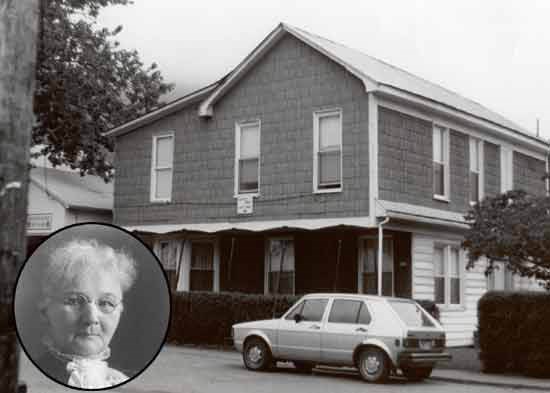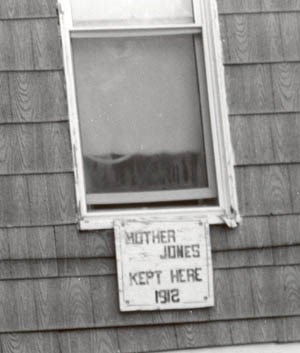
NPS Photo
Mother Jones Prison
Pratt, WV
Designated an NHL: April 27, 1992
Designation withdrawn: September 22, 1997
From 1912-1913, some of the most violent labor battles in American history took place in the Kanawha-New River coalfield of West Virginia. The most forceful strike leader was eighty-four year old Mother Jones, a veteran labor leader who had worked on behalf of all kinds of industrial workers in the United States. She was especially known for her work on behalf of coal miners; in West Virginia, she worked during five major strikes, the most significant of these being the Paint Creek-Cabin Creek strikes. Her three month imprisonment during these strikes focused national attention on the working conditions of coal miners and helped elicit public support for their cause.
The Kanawha Valley miners had been organized during a 1902 strike with the assistance of Mother Jones, but in the intervening years the union had been driven out of Cabin Creek. On April 1, 1912, the contract for the union Kanawha miners expired, and they tried to negotiate a new contract to improve their working conditions. Their demands were rejected and union miners throughout the Kanawha district went on strike on April 18th; eventually all the demands were met, except those of the Paint Creek miners who wanted wages equal to those paid in other area mines. Rejecting this, the Paint Creek operators instead began hiring guards from the Baldwin-Felts Detective Agency to intimidate, harass, and even physically assault miners and their families. As large contingents of these hired gunmen began to arrive in May, and violence between miners and guards became a daily occurrence.
The guards evicted miners from their rented houses and began to fortify coal company property, in preparation for the arrival of replacement or "scab" miners. Living in tent camps, hunger and sickness became endemic among the miners and their families. Mother Jones arrived in June and began to rouse the miners to act against the guards and the operators. Late in July, the union turned towards the non-union miners on Cabin Creek, attempting to persuade them to join the strike. Mother Jones made her way through armed guards to speak to the Cabin Creek miners at the town of Eskdale, and they went on strike shortly thereafter. They demanded that the mine operators recognize basic rights such as the right to organize and the right to free speech and assembly, as well as an end to the blacklisting of discharged miners, safeguards against cheating of the miners by the companies, and the removal of the mine guards.
As pitched gun battles between miners and guards broke out,Mother Jones' verbal attacks on the operators and the guards became ever more virulent and militant and she soon brought strikers to the state capitol. As Jones recounted in her autobiography, she "got three thousand armed miners to march over the hills secretly to Charleston, where we read a declaration of war to Governor Glasscock who, scared as a rabbit, met us on the steps of the state house. We gave him just twenty-four hours to get rid of the gunmen, promising him that hell would break loose if he didn't. He did. He sent the state militia in, who at least were responsible to society and not to the operators alone." Governor Glasscock did not send in the militia until two weeks later, however, when violence on a massive scale was imminent.
On September 1st, union miners from the north side of the Kanawha crossed over to join the Paint Creek and Cabin Creek strikers. Estimated to be as many as 6,000 strong, they were rumored to be planning a violent sweep down Cabin Creek to rout the mine guards and drive out any scab miners. Governor Glasscock declared martial law on September 2nd and sent in the state militia. The militia began to disarm both sides, confiscating large numbers of guns and stores of ammunition. The intervention of the state militia at first appeared to benefit the miners, but martial law prevented miners from congregating and the military court that was convened handed out speedy and often egregious sentences for striking miners. By October 15th, some calm had been restored and martial law was lifted; many militia members stayed in the area and became hired mine guards. As the mine operators brought more trainloads of scab workers into the area, however, the striking miners responded by attacking the trains. On November 15th, martial law was declared for a second time and a second military court was convened. This court not only presided over offenses committed within the strike district during martial law, but also offenses committed when martial law had been lifted, thus usurping the jurisdiction of civilian courts and denying the miners' right to civilian trials. Protections of both the West Virginia Constitution and the 14th Amendment of the U.S. Constitution were ignored by the military court and this position was upheld by the Supreme Court of West Virginia.
On January 10th, martial law was again lifted, but the imposed calm did not last very long. On the morning of February 7th, Mucklow was again attacked by miners, and a bookkeeper was killed. In response, with an arrest warrant for "John Doe", the county sheriff and his deputies, as well as a mine operator and guards boarded the "Bull Moose Special" on the night of the 7th. This armored train fitted with machine guns was ostensibly for defending against the miners, but it was used on this night to attack the miners' tent colony at Holly Grove. Under the direction of the mine operator, guards fired into the miners' tents; Cesco Estep was killed while getting his wife and child to safety. Miners attacked Mucklow two days later and on February 10th, martial law was again declared. Many mine guards resumed their former roles as militia members.
On February 12, 1913, Mother Jones was arrested in Charleston and sent back to Pratt. She recounted in her autobiography:
"The court had sent two lawyers to my bullpen to defend me, but I refused to let them defend me in that military court. I refused to recognize the jurisdiction of the court, to recognize the suspension of the civil courts. My arrest and trial were unconstitutional. I told the judge advocate that this was my position. I refused to enter a plea."
The offenses for which she was tried, according to her own account, included "stealing a cannon from the military, inciting to riot, putting dinimite [sic] under a track to blow up a C-O road." State Attorney General Lee recalled a conversation with Jones, in which she stated that her speech at Cabin Creek, made three months prior to the first martial law declaration, was the basis of her conviction. She was sentenced to twenty years in the state penitentiary.
Dr. Henry Hatfield was sworn in as the new governor of West Virginia on March 4, 1913 and he immediately traveled to the strike area. He encountered Mother Jones on his second day in the area, very sick with pneumonia and imprisoned in the military camp at Pratt. Jones was removed to Charleston for medical care, but when recovered she was returned to Pratt and imprisoned in Mrs. Carney's Boarding House. Governor Hatfield proceeded to issue terms for the settlement of the strike, which included many favorable provisions for the miners but that did not meet all of their demands. Threatened with deportation from the state, however, the Paint Creek miners accepted the settlement. The Cabin Creek miners remained on strike until the end of July, but did gain the removal of the Baldwin-Felts detectives.

NPS Photo
Mother Jones, however, was still being held at the boarding house in Pratt. In May, she smuggled a message to Senator John Kern of Indiana, using a trapdoor in the floor of her room to pass it to a friendly soldier. Senator Kern read the telegram while introducing a resolution authorizing the Senate Committee on Education and Labor to investigate conditions in West Virginia. Jones' telegram read:
"From out of the military prison wall of Pratt, West Virginia, where I have walked over my eighty-fourth milestone in history, I send you the groans and tears and heartaches of men, women, and children as I have heard them in this state. From out of these prison walls, I plead with you for the honor of the nation, to push that investigation, and the children yet unborn will rise and bless you."
As debate on the Kern resolution grew, Governor Hatfield had Jones released after eighty-five days, pardoning her and all the others convicted by the military courts. On May 27th, the Kern resolution passed in the Senate; it called for an investigation which would "seek to determine if a system of peonage existed in the strike zone, if immigration or postal laws were being violated, if strikers were being prosecuted contrary to federal law, and if certain other conditions existed." Jones' imprisonment had gained national attention and led to an inquiry into the working conditions of coal miners.
The Mother Jones Prison, the boarding house where Jones was held, was designated a National Historic Landmark on April 27, 1992. The building was demolished by the owners between April 1 and May 10, 1996. The Landmark designation of the Mother Jones Prison was withdrawn on September 22, 1997 and it was removed from the National Register of Historic Places.
Last updated: August 29, 2018
